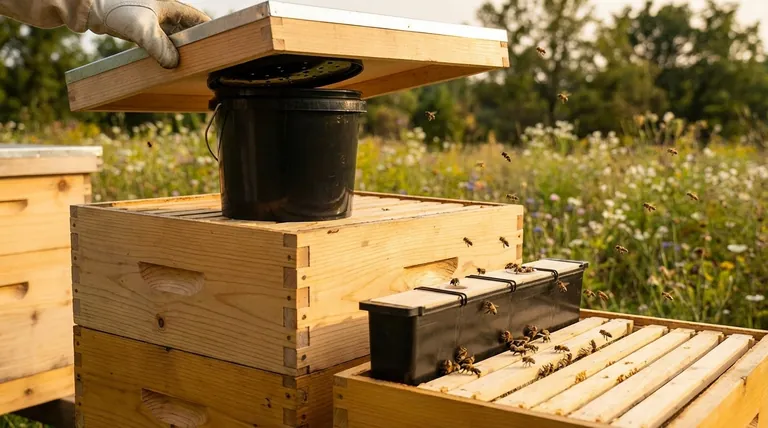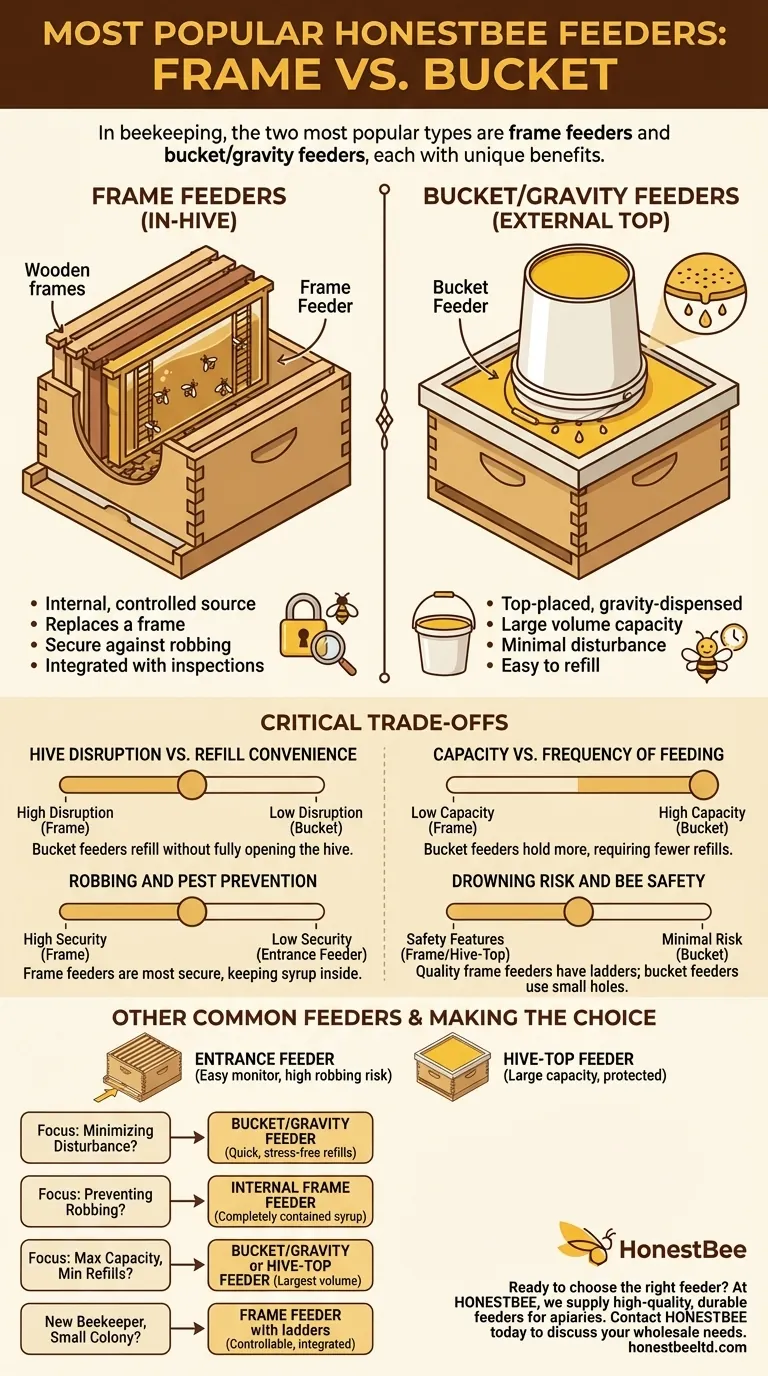In beekeeping, the two most popular types of feeders are frame feeders and bucket/gravity feeders. Frame feeders are placed inside the hive body in place of a frame, offering a controlled, internal food source. Bucket or gravity feeders are typically placed on top of the hive, using gravity to dispense a large volume of sugar syrup with minimal disturbance to the colony.
Choosing the right bee feeder isn't about finding a single "best" option. It's about understanding the critical trade-off between feeding capacity, hive disruption, and preventing access by pests.

A Closer Look at the Top Feeder Types
While many designs exist, the two most common feeders solve the problem of feeding in fundamentally different ways—one from inside the hive, and one from the outside.
Frame Feeders (In-Hive Division Board)
A frame feeder is a thin, plastic container shaped exactly like a standard hive frame. It's filled with syrup and placed inside the brood box or super, taking the place of one of the wooden frames.
Bees can access the syrup from within the hive. Most modern designs include built-in ladders or floats to prevent the bees from drowning.
Bucket or Gravity Feeders (External Top Feeders)
This is a simple and highly effective system. It consists of a bucket or can with very small holes in the lid, filled with syrup, and inverted over a hole in the hive's inner cover.
Gravity and vacuum pressure keep the syrup from pouring out, allowing bees to drink from the holes as needed. This method is exceptionally popular for its capacity and ease of use.
Exploring Other Common Feeder Designs
Beyond the two most popular types, beekeepers use a few other designs that suit specific situations or preferences.
Entrance / Boardman Feeders
This feeder consists of a small, inverted jar (often a Mason jar) that sits in a plastic or wooden tray at the hive entrance.
It's one of the easiest designs to monitor and refill. However, its position at the entrance can attract robber bees from other colonies and pests like wasps.
Hive-Top Feeders
These are large trays or reservoirs that sit directly on top of the uppermost hive box, enclosed by an empty box and the main hive cover.
They hold a very large volume of syrup and are well-protected from robbers and the weather. The main consideration is ensuring bees have safe access without the risk of drowning.
Understanding the Critical Trade-offs
Your choice of feeder directly impacts your workflow and the health of your colony. Understanding these trade-offs is key to making an informed decision.
Hive Disruption vs. Refill Convenience
Feeders like bucket, hive-top, and entrance feeders can be refilled without fully opening the hive. This minimizes stress on the bees.
A frame feeder, by contrast, requires you to open the hive completely, smoke the bees, and remove the feeder to refill it, integrating the task with a full hive inspection.
Capacity vs. Frequency of Feeding
Bucket and hive-top feeders offer the largest capacity, often holding a gallon or more. This is ideal for feeding large colonies or preparing for winter, as it reduces the number of times you need to refill.
Frame and entrance feeders hold significantly less, requiring more frequent attention from the beekeeper.
Robbing and Pest Prevention
This is a critical factor. In-hive feeders like frame and top feeders are the most secure, as the syrup is contained entirely within the hive.
Entrance feeders are the most likely to incite robbing because the food source is exposed and easily discovered by other insects.
Drowning Risk and Bee Safety
Any feeder with an open reservoir of syrup poses a drowning risk. High-quality frame and hive-top feeders include textured inner walls, ladders, or floats that allow bees to access the syrup safely.
Bucket feeders are generally very safe, as bees only have access to the small drops they can draw from the holes.
Making the Right Choice for Your Goal
Select a feeder based on your climate, the strength of your colony, and your beekeeping philosophy.
- If your primary focus is minimizing hive disturbance: A bucket/gravity feeder or a hive-top feeder allows for quick, stress-free refills.
- If your primary focus is preventing robbing from other insects: An internal frame feeder is the most secure option, keeping the syrup completely contained.
- If your primary focus is maximum capacity and minimal refills: A large hive-top or bucket feeder offers the largest volume for the least amount of work.
- If you are a new beekeeper starting with a small colony: A frame feeder with safety ladders is an excellent, controllable choice that integrates well with routine hive inspections.
Ultimately, the best feeder is the one that fits your beekeeping style and ensures your bees are well-fed and safe.
Summary Table:
| Feeder Type | Placement | Key Feature | Best For |
|---|---|---|---|
| Frame Feeder | Inside the hive (replaces a frame) | Internal, secure feeding | Preventing robbing, routine inspections |
| Bucket/Gravity Feeder | On top of the hive | Large capacity, gravity-fed | Minimizing disturbance, feeding large colonies |
Ready to choose the right feeder for your apiary?
At HONESTBEE, we supply commercial apiaries and beekeeping equipment distributors with the high-quality, durable feeders they need to succeed. Whether you're managing a few hives or a large-scale operation, the right equipment is crucial for colony health and productivity.
Let our experts help you select the best feeding solution for your specific goals. Contact HONESTBEE today to discuss your wholesale needs and ensure your bees are well-fed and thriving.
Visual Guide

Related Products
- Professional In-Hive Frame Bee Feeder by HONESTBEE
- Professional In-Hive Bee Feeder HONESTBEE Frame for Beekeeping
- Professional Hive Top Bee Feeder for Beekeeping
- 3.5L Plastic Beehive Frame Feeder Deep Frame Water Feeder for In Hive Use
- In-Hive Dual Compartment Frame Bee Feeder for Targeted Colony Nutrition
People Also Ask
- Are frame feeders good? Maximize Your Hive's Health with the Right Feeding Strategy
- What is a frame feeder and how does it work? An Efficient In-Hive Feeding Solution
- How do frame feeders prevent drowning of bees? Essential Safety Design for Healthy Hives
- What are the different types of honey bee feeders? Choose the Right Feeder for Your Hive
- What are the advantages of using a frame feeder? Boost Hive Health with In-Hive Feeding



















